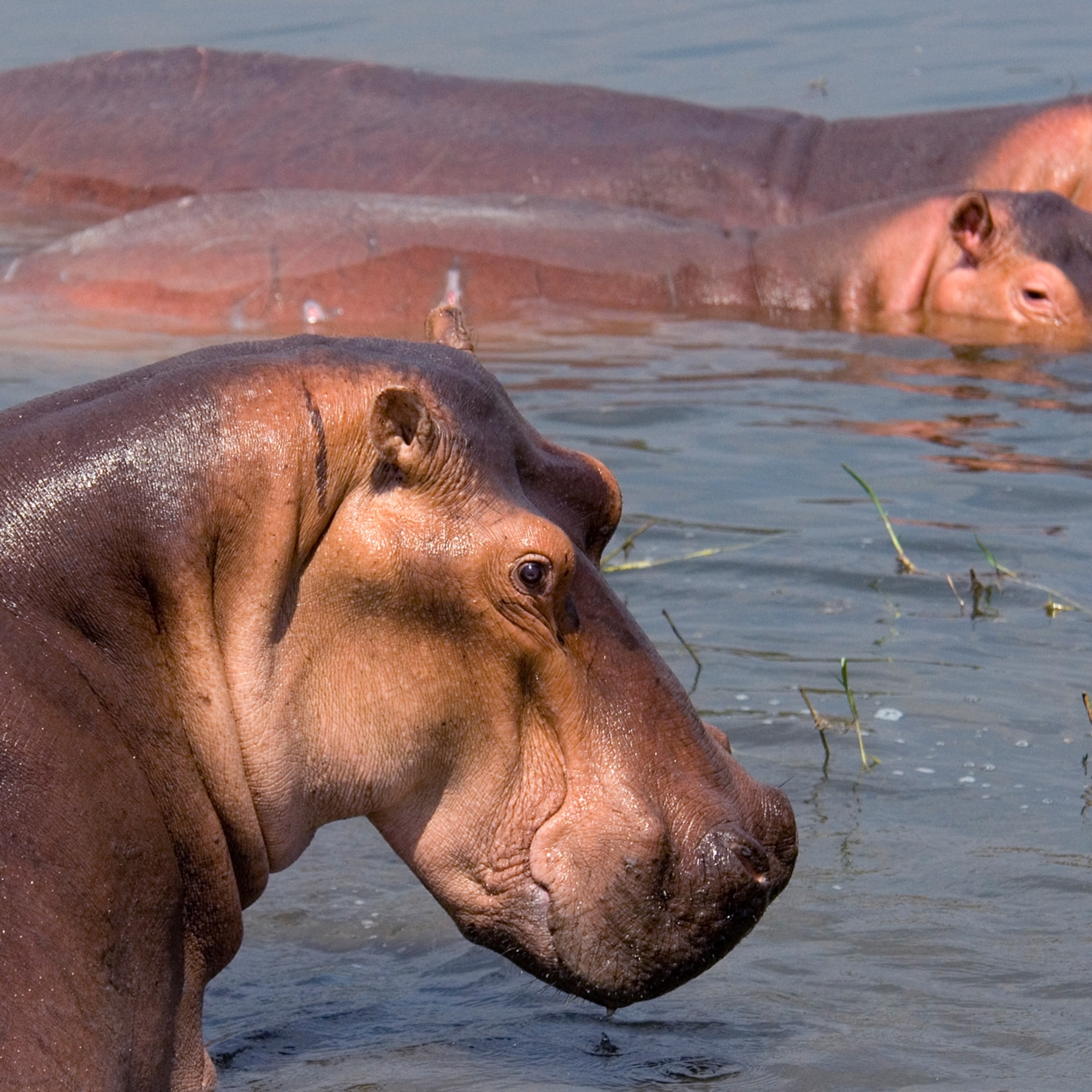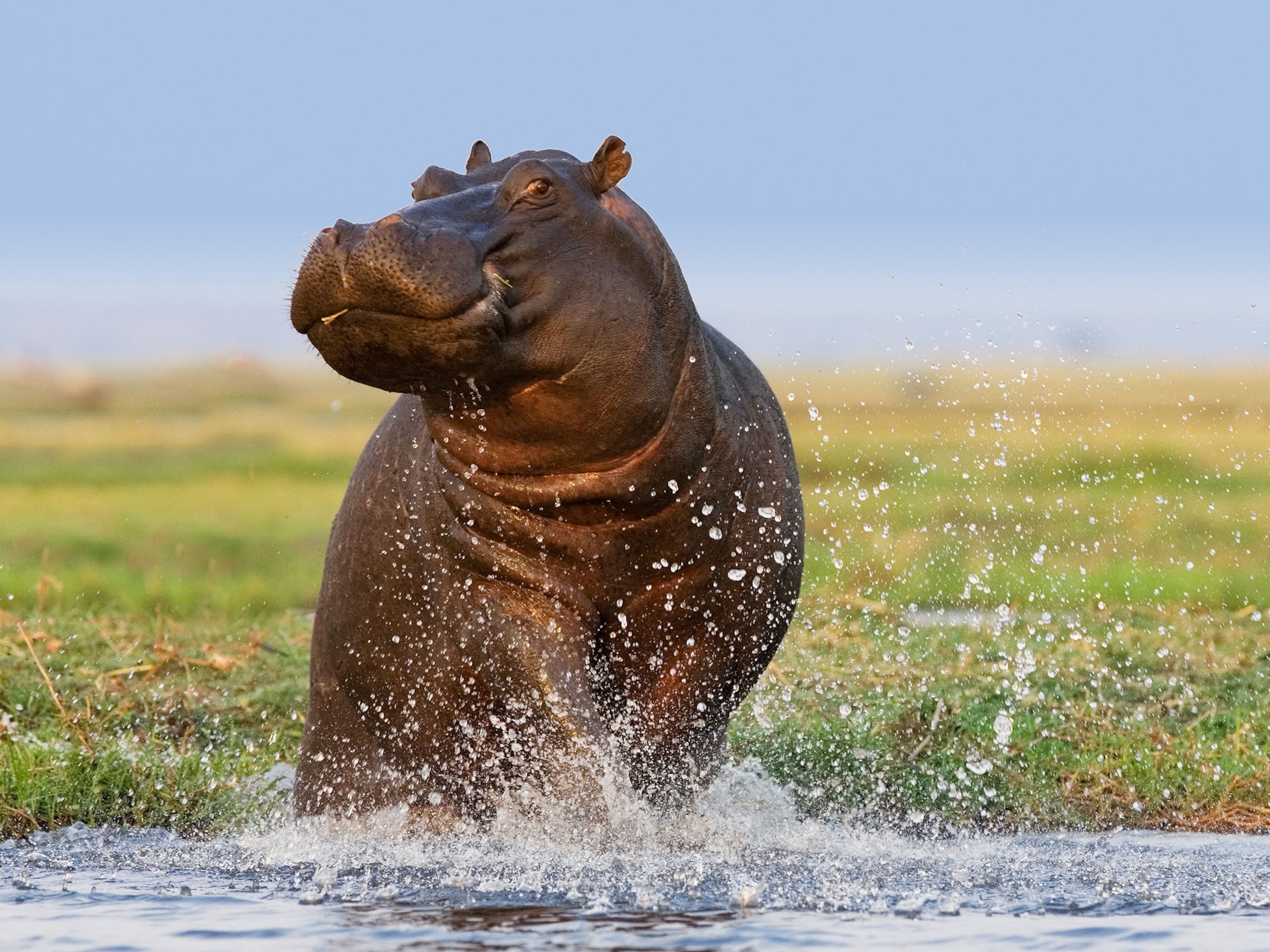When the notorious drug lord Pablo Escobar was shot dead in 1993, the Colombian government took control of his luxurious estate in northwestern Colombia, including his personal zoo. Most of the animals were shipped away, but the four hippopotamuses—of which Escobar was especially fond—were left to fend for themselves in a pond. Now, there are dozens and dozens of them.
For over a decade the Colombian government has been pondering how to best curb the growing population, a strategy largely supported by conservation experts. But not everyone is on board. Without direct evidence that the animals are doing harm, some ecologists argue that there’s no reason to cull or relocate them. Indeed, the hippos could fill in for species that humans pushed to extinction thousands of years ago—an idea known as rewilding.
When the hippos were left behind, it accidentally kicked off a rewilding experiment that’s now been running for more than 25 years. The first results of this experiment are trickling in and much like the large animals, they’re muddying the waters.
Known unknowns
The hippos have escaped Escobar’s former ranch and moved into Colombia’s main river, the Magdelena. Spread over a growing area, nobody knows exactly how many there are—but estimates indicate there may be a total population between 80 and 100, says Jonathan Shurin, an ecologist with University of California San Diego who studies the animals.
That’s at least a couple dozen higher than estimates just two years ago. Given that there were four in 1993, the population appears to be growing exponentially. “Within a couple of decades, there could be thousands of them.”
The hippos present quite a problem for the government. David Echeverri, a researcher with the Colombian government’s environmental agency Cornare, which is overseeing management of the animals, says he has no doubt they act like an invasive species. If allowed to remain unchecked, they will displace endemic animals like otters and manatees, he says. They also pose a danger to local residents since they can be territorial and aggressive, though no serious injuries or deaths have occurred as yet.
After one hippo was killed in 2009, there was a quick public outcry, quashing any plans to cull them. Instead, the government has been investigating ways to sterilize the creatures, or to move them out of the wild into captive facilities, Echeverri says. But the animals weigh thousands of pounds and aren’t exactly fond of human handling, so relocating or castrating them is both dangerous, difficult, and expensive. One juvenile hippo was successfully moved to a Colombian zoo in September 2018, but it cost 15 million pesos (about $4,500 USD).
For scientists and conservationists, the ultimate question is how these hippos impact the environment. The animals are foreigners, and in their native habitats they can have dramatic impacts on the landscape. Because they feed on land but excrete their waste in water, they funnel nutrients from terrestrial to aquatic environments. And when they alter water chemistry, they can make fish more vulnerable to predators. By simply moving their massive bodies through muddy areas, they can create channels for water flow that alter the structure of wetlands.
In fact, they affect local ecology so drastically that they’re considered “ecosystem engineers.” And while that makes them key members of African communities, it also means they could have strong effects on their introduced habitats.
To what end?
To further understand the animal’s environmental impacts, Shurin teamed up with Nelson Aranguren-Riaño from the Universidad Pedagógica y Tecnológica de Colombia, in a project funded by the National Geographic Society. They compared human-made lakes where the hippos hang out to ones they don’t frequent, looking at everything from the area’s ecological diversity to its microbes and productivity.
The research, published in late January in the journal Ecology, found some slight but detectable differences. “Hippo lakes have different chemistry and biology than no hippo lakes,” Shurin says. That’s mainly because the animals are fertilizing the water bodies they frequent with their feces. That can be problematic; these additional nutrients can lead to toxic algal blooms and even die-offs (something that hippos have caused in human-impacted watersheds in Africa).

Shurin emphasizes the differences are slight—“measurable, but not dramatic,” he says. “It wasn't like going from a super clean, clear-water lake to a super green lake; it was like going from a very green lake to even greener lake.”
That may be because the lakes examined in the study are already impacted by human activities. Next, Shurin and his colleagues would like to study the floodplain lakes of the Magdalena River where hippos have recently settled. But even the slight impact they’re having shouldn’t be ignored, he says. “If they have a detectable impact now—when they're relatively rare—then when they become much more common, that impact is certainly expected to increase.”
Filling a niche
But that may not be all bad. Some scientists have suggested nutrient pulses and even fish kills from hippos are actually a feature—not a flaw—of their presence. The addition of nutrients or oxygen-poor waters may subtly influence which species dominate in aquatic communities, or perhaps even increase the total species diversity by creating variable habitats within the river, some researchers suggest. Even large fish kills might have once served as a regular food resource for scavengers.
The scientists found that lakes with hippos had higher levels of cyanobacteria, commonly referred to as blue-green algae. But the hippos haven't yet impacted the quantity or variety of invertebrates or zooplankton.
Jens-Christian Svenning, a biologist with Aarhus University in Denmark, doesn’t think people should assume the worst. In a 2017 letter in the journal Perspectives in Ecology and Conservation, he and a colleague argued that Escobar’s hippos are one of several species introduced to South America that might contribute “ecosystem services” provided by large herbivores that are now gone.
In the case of the hippo, these might include: funneling nutrients from land to water; altering the structure of wetlands; and keeping grassy plants in check by eating them.
South America lost dozens of giant herbivore species in the last 20,000 years or so, including the somewhat hippo-esque toxodons, which may have been semi-aquatic, as well as water-loving tapirs. Although several tapir species remain today, all are declining. “Hippos could likely contribute a partial restoration of these effects, likely benefitting native biodiversity overall,” Svenning says. He’d let the hippos be for now, while monitoring the creatures to ensure they don’t become a problem.
Shurin notes that the animals may be providing a valuable service for native plants that once relied on large, now-extinct mammals to disperse their seeds. “We're planning to look at their poop and see what's in there,” he says.
But while he says it’s possible they’re stepping into roles that have been vacant for millennia, that may not be something the humans in the area ultimately want. No one really knows how native wildlife like manatees, river turtles, and otters will be affected by that kind of rewilding, and more hippos may mean increased conflict with people.
“Right now, the people are just coexisting with them,” he says. But that could change if this population of notoriously disagreeable animals grows exponentially. “There's concern about public safety.”
A story of survival
To Arian Wallach, an ecologist with the University of Technology, Sydney in Australia, whether they can perfectly fill a lost niche or not isn’t really the point. She stresses that hippos are considered vulnerable to extinction, and considers having a refuge population outside of Africa to be a boon. “The fact that there are wild hippopotamuses in South America [is] a wonderful story of survival, of agency, of pioneering,” she says.
Wallach is not alone in her positive feelings; the animals have many fans. “There’s a local contingency that sees value in them and wants them to stay,” explains Shurin. “The charisma of the hippos and the fact that they are such celebrities creates quite the complex situation,” Echeverri adds.
They also attract tourists and tourism dollars, which my help offset some concerns about the animals. Upwards of 50,000 tourists visit Hacienda Napoles every year, according to some estimates.
For now, without immediate plans to relocate or sterilize all the animals, the creatures will continue to fend for themselves and expand. Shurin looks forward to studying the long-term impacts of their residency, assuming they indeed remain. “It's a big experiment,” says Shurin—and “we're going to find out.”
Related Topics
Go Further
Animals
-
This ‘saber-toothed’ salmon wasn’t quite what we thoughtThis ‘saber-toothed’ salmon wasn’t quite what we thought
-
Why this rhino-zebra friendship makes perfect senseWhy this rhino-zebra friendship makes perfect sense
-
When did bioluminescence evolve? It’s older than we thought.When did bioluminescence evolve? It’s older than we thought.
-
Soy, skim … spider. Are any of these technically milk?Soy, skim … spider. Are any of these technically milk?
-
This pristine piece of the Amazon shows nature’s resilienceThis pristine piece of the Amazon shows nature’s resilience
Environment
-
This pristine piece of the Amazon shows nature’s resilienceThis pristine piece of the Amazon shows nature’s resilience
-
Listen to 30 years of climate change transformed into haunting musicListen to 30 years of climate change transformed into haunting music
-
This ancient society tried to stop El Niño—with child sacrificeThis ancient society tried to stop El Niño—with child sacrifice
-
U.S. plans to clean its drinking water. What does that mean?U.S. plans to clean its drinking water. What does that mean?
History & Culture
-
Séances at the White House? Why these first ladies turned to the occultSéances at the White House? Why these first ladies turned to the occult
-
Gambling is everywhere now. When is that a problem?Gambling is everywhere now. When is that a problem?
-
Beauty is pain—at least it was in 17th-century SpainBeauty is pain—at least it was in 17th-century Spain
-
The real spies who inspired ‘The Ministry of Ungentlemanly Warfare’The real spies who inspired ‘The Ministry of Ungentlemanly Warfare’
-
Heard of Zoroastrianism? The religion still has fervent followersHeard of Zoroastrianism? The religion still has fervent followers
Science
-
Here's how astronomers found one of the rarest phenomenons in spaceHere's how astronomers found one of the rarest phenomenons in space
-
Not an extrovert or introvert? There’s a word for that.Not an extrovert or introvert? There’s a word for that.
-
NASA has a plan to clean up space junk—but is going green enough?NASA has a plan to clean up space junk—but is going green enough?
-
Soy, skim … spider. Are any of these technically milk?Soy, skim … spider. Are any of these technically milk?
-
Can aspirin help protect against colorectal cancers?Can aspirin help protect against colorectal cancers?
Travel
-
What it's like to hike the Camino del Mayab in MexicoWhat it's like to hike the Camino del Mayab in Mexico
-
Is this small English town Yorkshire's culinary capital?Is this small English town Yorkshire's culinary capital?
-
Follow in the footsteps of Robin Hood in Sherwood ForestFollow in the footsteps of Robin Hood in Sherwood Forest
-
This chef is taking Indian cuisine in a bold new directionThis chef is taking Indian cuisine in a bold new direction










